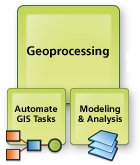Geoprocessing is a framework and set of tools for processing geographic and related data. The comprehensive suite of geoprocessing tools can be used to perform spatial analysis or manage GIS data in an automated workflow. Geoprocessing can be used by everyone that uses ArcGIS AllSource. Whether you are a new or advanced user, geoprocessing may be an essential part of your day-to-day work.

A typical geoprocessing tool performs an operation on a dataset such as a feature class, raster, or table, and creates a resulting output dataset. For example, the Buffer tool uses features as input, creates buffer areas around the features to a specified distance, and writes those buffer areas to a new output dataset.
In addition to the suite of tools, the geoprocessing framework supports control of the processing environment and allows you to build custom tools that can further automate your work. You can use the geoprocessing tools included in ArcGIS AllSource to create custom tools that automate repetitive tasks or solve complex problems.
In ArcGIS AllSource you can do the following:
- Find the geoprocessing tool that is right for the job by searching or browsing a list of tools.
- Run the geoprocessing tool after specifying parameter settings and other options.
- View the geoprocessing history of a project.
- Create and use custom geoprocessing tools that automate your work.
- Use batch geoprocessing for repetitive tasks by running a tool multiple times.
- Save sets of geoprocessing tools that are important to various projects.
- Access the ArcGIS platform by running analytic tools available through your portal.
Get started with a quick tour of geoprocessing in ArcGIS AllSource or the Use geoprocessing tools quick-start tutorial.